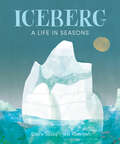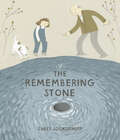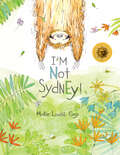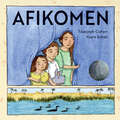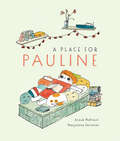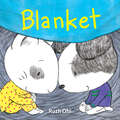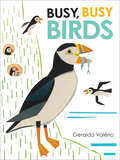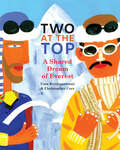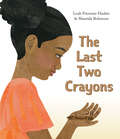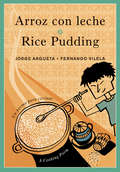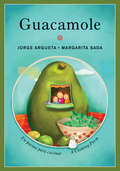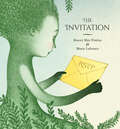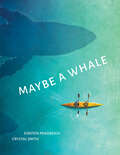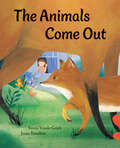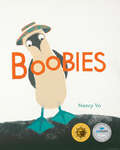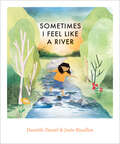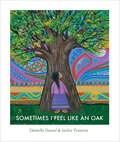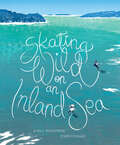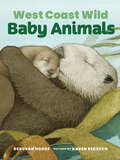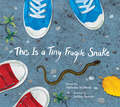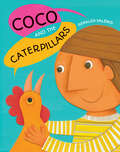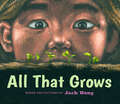- Table View
- List View
Iceberg: A Life in Seasons
by Claire SaxbyAn iceberg shears from a glacier and begins a journey that takes it through Antarctica’s seasons. Follow the iceberg in the spring as it watches penguins trek across the ice to their winter homes and senses krill stirring underneath the ice. With summer comes more life: the iceberg sees humpback whales spiral and orca gather. And the iceberg moves too, ever shrinking as the sun softens its edges and undersea currents wash it from below. When autumn arrives with cooling temperatures, the sea changes and the iceberg is trapped in the ice for the winter freeze. Then spring returns and the iceberg drifts into a sheltered bay and falls, at the end of its life cycle. But if you think this is the end of the journey, look closer — out in the ocean, an iceberg shears from a glacier and settles to the sea, beginning the process anew. Ocean, sky, snow and ice dance a delicate dance in this evocative portrayal of the life cycle of an iceberg. The poetic text and beautiful illustrations make this a unique nonfiction offering for young readers. This book ends with an author’s note explaining the effects of climate change on the Arctic and Antarctic regions, as well as a map and a glossary. Key Text Features additional information author’s note glossary map gatefold Correlates to the Common Core State Standards in English Language Arts: CCSS.ELA-LITERACY.RI.1.4 Ask and answer questions to help determine or clarify the meaning of words and phrases in a text.
The Remembering Stone
by Carey SookocheffAlice keeps a perfectly round skipping stone in her pocket to remember her grandfather by — but the stone goes missing. It looked just like a regular stone, but Alice knew it was different: It was perfectly round so you could use it to trace circles, and sometimes she could trick her dad into thinking it was a quarter. It was also how Alice remembered her grandpa, who taught her how to skip stones, and who passed away last winter. Alice brings the stone to school for Show and Share, but when her classmate asks to see it again at recess, Alice discovers that the stone is gone! Her friends search high and low and can’t find the stone—but their friendship gives Alice an idea of another way that she can remember. A gentle look at loss, grief, and how small everyday actions can connect us to those we love. Key Text Features Illustrations Correlates to the Common Core State Standards in English Language Arts: CCSS.ELA-LITERACY.RL.K.3 With prompting and support, identify characters, settings, and major events in a story.
I’m Not Sydney!
by Marie-Louise GaySydney and his friends gather outside to play, transforming one by one to climb, leap, lumber and soar into a shared jungle of their imagination. Hanging upside down in a tree, Sydney imagines he is a sleepy, sun-bathing sloth. And that's where Sami finds him. Sami thinks sloths are too slow, so she scampers up the tree and becomes a spider monkey. “Fast is fun!” she chatters. “Fast is best!” And that’s where Edward finds them… One after another, the neighborhood kids wander by and slip into a shared imaginative world where leaves and giant flowers unfurl, playing, laughing, teasing and bickering, until Edward the elephant fills up his trunk and—WHOOSH!—sends the children “galloping home like a herd of small wet animals.” As always, Marie-Louise Gay’s writing and artwork are wonderfully pitched to young readers, capturing the effortless way that children travel back and forth between the worlds of real life and make believe. With its sun-dappled watercolors, depiction of time spent outdoors with friends, and quiet, wistful ending, I’m Not Sydney perfectly illustrates the slow-moving magic of a childhood summer. Key Text Features illustrations Correlates to the Common Core State Standards in English Language Arts: CCSS.ELA-LITERACY.RL.1.4 Identify words and phrases in stories or poems that suggest feelings or appeal to the senses. CCSS.ELA-LITERACY.RL.1.7 Use illustrations and details in a story to describe its characters, setting, or events.
Afikomen
by Tziporah CohenIn this wordless time-travel adventure, three children at a Passover seder visit ancient Egypt to help baby Moses find his way safely to Pharaoh’s daughter. When a family settles at the table for Passover, their dog nabs the afikomen bag (containing matzah used for the seder) and dives under the tablecloth. The children follow him and find themselves transported to ancient Egypt. There, they see baby Moses’ mother and sister Miriam placing him in a reed basket. The baby’s journey down the Nile is hazardous — he encounters several obstacles along the way, including a wily crocodile. Thanks to the three children, he reaches his destination unharmed, with a piece of afikomen tucked into his basket. The children return to the seder table and, exhausted, fall asleep. But what are their parents to make of the grains of sand in the afikomen bag? Includes an author’s note about the meaning of the Passover holiday and about different afikomen traditions. Key Text Features author’s note explanation illustrations literary references panels sources wordless Correlates to the Common Core States Standards in English Language Arts: CCSS.ELA-LITERACY.RL.K.3 With prompting and support, identify characters, settings, and major events in a story. CCSS.ELA-LITERACY.RL.1.3 Describe characters, settings, and major events in a story, using key details. CCSS.ELA-LITERACY.RL.1.7 Use illustrations and details in a story to describe its characters, setting, or events.
A Place for Pauline
by Anouk MahioutAs the eldest child in a large family, Pauline struggles to find her niche, and she longs for peace and quiet — a charming story in graphic-novel style. Pauline lives with her mother, father, little brother and sister, and there’s a new baby on the way. Her friends tell her she’s lucky to be the eldest — she’s the one who gets new clothes and can stay up late — but Pauline isn’t so sure. In her busy, crowded, noisy house, she never knows what she’s supposed to do. One minute she’s told to help her little sister, and the next to leave her alone! It seems like she’s never in the right place at the right time, and her brother seems determined to prevent her from reading in peace. So Pauline finds a secret hideaway, and in this quiet place, surrounded by her precious belongings, she can read her favorite books, make up stories and imagine being as free as a bird. But most of all, she dreams of sailing off to France where her grandmother lives, and one day she decides to do just that … Funny and touching, this story highlights the importance of finding our place, while gently exploring feelings about solitude, freedom, independence and the comforts of home. Key Text Features comic comic strips dialogue illustrations lyrics panels song lyrics speech bubbles Correlates to the Common Core State Standards in English Language Arts: CCSS.ELA-LITERACY.RL.1.2 Retell stories, including key details, and demonstrate understanding of their central message or lesson. CCSS.ELA-LITERACY.RL.2.3 Describe how characters in a story respond to major events and challenges. CCSS.ELA-LITERACY.RL.3.7 Explain how specific aspects of a text's illustrations contribute to what is conveyed by the words in a story (e.g., create mood, emphasize aspects of a character or setting) CCSS.ELA-LITERACY.RL.4.2 Determine a theme of a story, drama, or poem from details in the text; summarize the text.
Blanket
by Ruth OhiA gentle wordless picture book about the difference a kind friend can make on a gray day. It’s a beautiful morning, but when Cat wakes up, the world feels gray. Cat wraps up in a blanket and hides — until Dog comes in. What can Dog do to help Cat? Dog joins Cat under the blanket and listens to Cat’s worries. Dog’s flashlight illuminates the darkness and brings laughter. The two friends build a blanket fort where they can make shadow puppets and find comfort in storybooks. Dog makes sandwiches so that they can share a picnic meal. With Dog’s help, Cat discovers ways to cope until the sadness starts to lift. Ruth Ohi’s first wordless picture book is a quiet, heartfelt story about those times when you just want to hide under a blanket — and how much it can mean to have a friend who will be there to keep you company. Key Text Features comic comic strips illustrations Correlates to the Common Core State Standards in English Language Arts: CCSS.ELA-LITERACY.RL.K.6 With prompting and support, name the author and illustrator of a story and define the role of each in telling the story. CCSS.ELA-LITERACY.RL.K.7 With prompting and support, describe the relationship between illustrations and the story in which they appear (e.g., what moment in a story an illustration depicts). CCSS.ELA-LITERACY.RL.1.2 Retell stories, including key details, and demonstrate understanding of their central message or lesson.
Busy, Busy Birds
by Geraldo ValérioThis lively board book introduces young ones to a colorful collection of very busy birds. These birds are busy! Most of our feathered friends fly, but what about the ones that soar or strut, paddle or perch? Explore the kinetic lives of birds through captivating collage illustrations, filled with bright colors and strong shapes. Playful text will introduce infants and toddlers to a variety of verbs, making this a fun read-aloud for bird lovers of all ages. Key Text Features labels illustrations
Two at the Top: A Shared Dream of Everest
by Uma KrishnaswamiTenzing Norgay and Edmund Hillary each tell their story, culminating in their thrilling ascent of Mount Everest. Tenzing Norgay grew up in Nepal, herding yaks in the shadow of Chomolungma, the mountain also known as Everest. He has always dreamed of climbing to the top. He becomes a guide, leading treks through the Himalayas, and finally attempts the highest mountain himself, but doesn’t make it. Across the ocean, in New Zealand, Edmund Hillary grew up tending his father’s bees. He climbed his first mountain at sixteen and has climbed all over the world ever since. He tries Everest, with no success. In 1953, the two men set out on the same expedition to climb Everest. Their party numbers four hundred, counting all the guides and porters. But the climb is grueling, and eventually Norgay and Hillary are the only two determined to continue. They tramp over windswept glaciers, crawl across rope bridges, hack footholds in the ice … until finally they reach the top of the world! This remarkable true adventure story, told in a dual narrative, includes illustrated backmatter rich in geography, history and science. Key Text Features author’s note bibliography facts further reading historical context illustrations Correlates to the Common Core State Standards in English Language Arts: CCSS.ELA-LITERACY.RL.K.3 With prompting and support, identify characters, settings, and major events in a story. CCSS.ELA-LITERACY.RL.1.3 Describe characters, settings, and major events in a story, using key details.
The Last Two Crayons
by Leah Freeman-HaskinSienna looks forward to drawing a picture for her school’s spring art show, until she ends up with the last two crayons … By the time Sienna arrives at the art table in her classroom, all the crayons are gone except dark brown and light brown. Now how can she make a special picture for the art show? Andy teases that all she’ll be able to draw is mud and dog poop. Her teacher tries to cheer her up, telling her that lots of wonderful things are brown. So Sienna imagines some of her favorite things — her grandma’s rose garden, her new bicycle, rainbows — but none of them are brown! Her friends remind her that chocolate ice cream is brown, and so is the grizzly bear at the zoo. Sienna draws both, with the help of her friends, but neither picture seems special enough. In the end, inspired by an early memory, Sienna comes up with her own idea for a drawing that’s perfect for the art show. The Last Two Crayons looks at the beautiful world of brown, with a heartwarming and empowering ending that celebrates diversity, creativity and family. Key Text Features dialogue illustrations vignettes Correlates to the Common Core State Standards in English Language Arts: CCSS.ELA-LITERACY.RL.1.2 Retell stories, including key details, and demonstrate understanding of their central message or lesson. CCSS.ELA-LITERACY.RL.1.4 Identify words and phrases in stories or poems that suggest feelings or appeal to the senses. CCSS.ELA-LITERACY.RL.1.7 Use illustrations and details in a story to describe its characters, setting, or events.
Arroz con leche / Rice Pudding: Un poema para cocinar / A Cooking Poem
by Jorge ArguetaThe second title of Jorge Argueta's popular bilingual Cooking Poems series, celebrates the joys of preparing, eating and sharing food. Now available in paperback, Arroz con leche / Rice Pudding is the second title of Jorge Argueta’s popular bilingual Cooking Poems series, celebrating the joys of preparing, eating and sharing food. From sprinkling the rice into the pot, to adding a waterfall of milk, cinnamon sticks, salt stars and sugar snow, Jorge Argueta’s recipe is not only easy to follow, it is a poetic experience. The lively illustrations by Fernando Vilela feature an enthusiastic young cook who finds no end of joy in making and then slurping up the rice pudding with his family. As in all the titles in this series, Arroz con leche / Rice Pudding conveys the pleasure of making something delicious to eat for people you really love. A great book for families to enjoy together. Correlates to the Common Core State Standards in English Language Arts: CCSS.ELA-LITERACY.RI.K.2 With prompting and support, identify the main topic and retell key details of a text.
Guacamole: Un poema para cocinar / A Cooking Poem (Bilingual Cooking Poems)
by Jorge ArguetaGuacamole is the third title of Jorge Argueta's popular bilingual Cooking Poems series, celebrating the joys of preparing, eating and sharing food. Now available in paperback, Guacamole is the third title of Jorge Argueta’s popular bilingual Cooking Poems series, celebrating the joys of preparing, eating and sharing food. Guacamole originated in Mexico with the Aztecs and has long been popular in North America, especially in recent years due to the many health benefits of avocados. This version of the recipe is easy to make, calling for just avocados, limes, cilantro and salt. A little girl dons her apron, singing and dancing around the kitchen as she shows us what to do. Poet Jorge Argueta sees beauty, magic and fun in everything around him — avocados are like green precious stones, salt falls like rain, cilantro looks like a little tree and the spoon that scoops the avocado from its skin is like a tractor. As in all the titles in this series, Guacamole conveys the pleasure of making something delicious to eat for people you really love. A great book for families to enjoy together. Correlates to the Common Core State Standards in English Language Arts: CCSS.ELA-LITERACY.RI.K.2 With prompting and support, identify the main topic and retell key details of a text. CCSS.ELA-LITERACY.RI.K.5 Identify the front cover, back cover, and title page of a book. CCSS.ELA-LITERACY.RI.K.6 Name the author and illustrator of a text and define the role of each in presenting the ideas or information in a text.
The Invitation
by Stacey May FowlesStacey May Fowles’ debut picture book is a whimsical, warmhearted story of how a super-special surprise can lead to anxiety — or invite imagination. One beautiful fall day, Fern opens her mailbox and finds an envelope. After much worrying about what it could possibly contain, her friend Fawn encourages her to open it. Inside, she finds an invitation to a super-special surprise at the museum — but Fern doesn’t like surprises! Luckily, Fawn offers to come with her to the party. What could possibly happen, he asks. Along the way, Fern voices her worries: What if they can’t make it in time? What if they don’t know anyone there? Fawn playfully follows his friend's way of thinking, while gently suggesting twists to her story and a fun new cast of characters — the chipmunk who could show them a shortcut, the grumpy bear who could clear their path, the brave dentist who might treat the bear’s toothache — until at last they arrive, and Fern is able to enjoy the wonderful surprise happening around her. Marie Lafrance’s delightfully dreamy illustrations bring the imagined world of Fern and Fawn to life in this super-special story about catastrophic thinking. Key Text Features illustrations Correlates to the Common Core State Standards in English Language Arts: CCSS.ELA-LITERACY.RL.1.3 Describe characters, settings, and major events in a story, using key details. CCSS.ELA-LITERACY.RL.1.4 Identify words and phrases in stories or poems that suggest feelings or appeal to the senses. CCSS.ELA-LITERACY.RL.1.7 Use illustrations and details in a story to describe its characters, setting, or events.
Maybe a Whale
by Kirsten PendreighAfter Grandpa dies, a girl and her mother take the trip he had planned for her, kayaking along the Pacific west coast to look for the whales that he loved. The trip will do them good, Mom says, but the girl isn’t sure. How can that be true when Grandpa isn’t there? And how will they find a whale in all that water, anyway? There is so much to see as they paddle through white-tipped waves and calm coves: glowing moon jellies, fluttering anemones and slippery seals. All the while, the girl watches for whales. Could one be swimming beneath their kayak or along the shore of their camp? Are the whales even there? Finally, in the dark of night, they hear them — pushhhhhhhh, pushhhhhhh — humpbacks breathing in the bay. In this lyrical story, luminously illustrated by Crystal Smith, mom and daughter find the space to grieve Grandpa and reconnect with each other in the wild beauty of nature. And they come to realize that — perhaps like whales — those we’ve loved are always with us, even if we don’t see them anymore. Key Text Features illustrations Correlates to the Common Core State Standards in English Language Arts: CCSS.ELA-LITERACY.RL.1.3 Describe characters, settings, and major events in a story, using key details. CCSS.ELA-LITERACY.RL.1.4 Identify words and phrases in stories or poems that suggest feelings or appeal to the senses. CCSS.ELA-LITERACY.RL.1.7 Use illustrations and details in a story to describe its characters, setting, or events.
The Animals Come Out
by Susan Vande GriekDo you ever wonder what could happen if we all hid away? If we stayed in, we just might see … the animals come out! A delightful series of poems describes the many animals that emerge from the woods, the hills and the skies when we are not around. Peek out your window and watch the deer grazing under the streetlights, the rabbits hopping through our vegetable gardens, and the ducks quack quack quacking along the sidewalks. The Animals Come Out was inspired by the wildlife seen in quieted urban areas during the early days of the COVID-19 pandemic, a situation that young readers may well remember. But this book also encourages readers to be aware that, in fact, we share the outdoors with these animals all the time, and to consider the impact that we have upon them. Key Text Features illustrations Correlates to the Common Core State Standards in English Language Arts: CCSS.ELA-LITERACY.RL.1.3 Describe characters, settings, and major events in a story, using key details. CCSS.ELA-LITERACY.RL.1.4 Identify words and phrases in stories or poems that suggest feelings or appeal to the senses. CCSS.ELA-LITERACY.RL.2.4 Describe how words and phrases (e.g., regular beats, alliteration, rhymes, repeated lines) supply rhythm and meaning in a story, poem, or song.
The Little Green Envelope
by Gillian SzeA little green envelope longs to go on a journey. Will it be chosen to deliver Olive’s letter to her far-away friend? Olive’s friend has moved away, and Olive wishes she could visit her. A little green envelope, lost in the bottom of the desk drawer, knows how Olive feels. It, too, wants so much to travel, and imagines zipping up and down conveyer belts and bouncing along in a mail bag, on its way to deliver an important letter. An old postcard reassures that for every occasion, there is an envelope … but it seems like it will never be the little green envelope’s turn. When Olive’s grandpa suggests writing her friend a letter, the little green envelope hopes and hopes that it will be chosen to carry the letter to its destination — but will it be a perfect fit? A diagram on the endpapers shows how readers can create their own little green envelopes! Key Text Features illustrations Correlates to the Common Core State Standards in English Language Arts: CCSS.ELA-LITERACY.RL.K.6 With prompting and support, name the author and illustrator of a story and define the role of each in telling the story. CCSS.ELA-LITERACY.RL.1.3 Describe characters, settings, and major events in a story, using key details.
Boobies
by Nancy VoA cheeky celebration of boobies! “You have just opened a book about boobies.” Meet the Blue-footed Booby, who does not have any boobies at all, since only mammals have boobies. We learn that mammals have boobies to feed babies — even though milk can also come from plants. And did you know that boobies, or breasts, vary from person to person, that boobies change over time, and that different animals have different numbers of boobies? Witty and wide-ranging, this eye-opening picture book goes on to explore connections between boobies and mountains, boobies and ancient art and, of course, boobies and you! Nancy Vo’s latest creation is fresh and funny, while serving up just the right amount of fact. Punchy prose is complemented by striking stencil art in a retro palette, making this the perfect gift for curious young children, older children getting to know their bodies, and anyone ready to boldly celebrate boobies! Key Text Features explanation facts illustrations labels map timeline vignettes Correlates to the Common Core State Standards in English Language Arts: CCSS.ELA-LITERACY.RI.K.2 With prompting and support, identify the main topic and retell key details of a text. CCSS.ELA-LITERACY.RI.1.2 Identify the main topic and retell key details of a text. CCSS.ELA-LITERACY.RI.1.7 Use the illustrations and details in a text to describe its key ideas.
Sometimes I Feel Like a River (Sometimes I Feel Like #2)
by Danielle DanielFollowing the huge success of Sometimes I Feel Like a Fox, this companion book is a lyrical celebration of our relationship to the natural world. In each of twelve short poems, a child tells us how or why they feel like the sun, a river, a mountain, a cloud, the rain, a forest and more. Their deeply felt connections and identification with these wonders point to how much we are all part of the natural world. Each poem comes to life through vivid, playful illustrations that show the children immersed in their surroundings. The book serves as a gentle call to action — to notice, appreciate, preserve and protect our environment, while delighting in all its beauty. A mindfulness activity — A Mindful Walk or Roll — invites young readers to use their senses to experience their surroundings to the fullest. Includes a brief author’s note that highlights our connections to the natural world. Key Text Features author’s note illustrations poems procedural text Correlates to the Common Core State Standards in English Language Arts: CCSS.ELA-LITERACY.RL.K.5 Recognize common types of texts (e.g., storybooks, poems). CCSS.ELA-LITERACY.RL.1.2 Retell stories, including key details, and demonstrate understanding of their central message or lesson. CCSS.ELA-LITERACY.RL.1.4 Identify words and phrases in stories or poems that suggest feelings or appeal to the senses.
Sometimes I Feel Like an Oak (Sometimes I Feel Like #3)
by Danielle DanielFollowing the success of Sometimes I Feel Like a Fox and Sometimes I Feel Like a River, this companion book explores the nature and beauty of trees. Twelve lyrical poems look at twelve different trees, from early spring to deep winter. In each poem, a child identifies with a feature of the tree — such as the smooth trunk of a birch whose bark has peeled away, the strong branches of a spruce that shelter small birds or the pink flowers of a cherry blossom that tumble like confetti. The poems provide an opportunity to learn about each tree, inspiring us to look afresh at the trees around us — whether in the schoolyard, neighborhood or park — and get to know them better. Danielle Daniel’s passion for trees is beautifully matched by Jackie Traverse’s paintings, which bring each tree to life. In the pages following the poems, children are invited to consider what different kinds of trees might mean to them. In an author’s note, Danielle Daniel shares her belief, similar to her Algonquin ancestors’, that trees are sentient beings with much to give and teach us. Key Text Features illustrations author’s note poems Correlates to the Common Core States Standards in English Language Arts: CCSS.ELA-LITERACY.RL.K.5 Recognize common types of texts (e.g., storybooks, poems). CCSS.ELA-LITERACY.RL.K.6 With prompting and support, name the author and illustrator of a story and define the role of each in telling the story. CCSS.ELA-LITERACY.RL.1.4 Identify words and phrases in stories or poems that suggest feelings or appeal to the senses.
We Are Lions!
by Jens MattssonI am a lion, and my big brother is one, too … until one day, he gets sick. The narrator and his big brother have the best game in the world together. They are dangerous lions on the savannah! One day, big brother doesn’t want to run around anymore. His stomach hurts. He has to see the doctor and take medicine, and even has to stay at the hospital. Lions don’t want to be trapped by wires and tubes! The narrator instigates a hunt, and the brothers run around the hospital together, chasing gazelles and startling the wildebeest. But big brother is very sick and can't keep up. Lions can’t cry, his little brother insists. But they can miss the rest of their pride. With Mom and Dad, the narrator tries to comfort his sibling. Soon, he knows, the two lions will go hunting again. A tender story, unexpectedly punctuated by moments of humor, about the illness of a sibling, the love between brothers and the healing power of imagination. Key Text Features illustrations Correlates to the Common Core State Standards in English Language Arts: CCSS.ELA-LITERACY.RL.K.3 With prompting and support, identify characters, settings, and major events in a story. CCSS.ELA-LITERACY.RL.1.2 Retell stories, including key details, and demonstrate understanding of their central message or lesson. CCSS.ELA-LITERACY.RL.1.4 Identify words and phrases in stories or poems that suggest feelings or appeal to the senses. CCSS.ELA-LITERACY.RL.1.7 Use illustrations and details in a story to describe its characters, setting, or events.
Skating Wild on an Inland Sea
by Jean E. PendziwolLet’s go! Experience the magic of skating on wild ice. Two children wake up to hear the lake singing, then the wind begins wailing … or is it a wolf? They bundle up and venture out into the cold, carrying their skates. On the snow-covered shore, they spot tracks made by fox, deer, hare, mink, otter … and the wolf! In the bay, the ice is thick and smooth. They lace up their skates, step onto the ice, stroking and gliding, and the great lake sings again. In her signature poetic style, Jean E. Pendziwol describes the exhilarating experience of skating on the wild ice of Lake Superior, including the haunting singing that occurs as the ice expands and contracts. Accompanied by Todd Stewart’s breathtaking illustrations, this book will make us all long to skate wild! Key Text Features illustrations Correlates to the Common Core State Standards in English Language Arts: CCSS.ELA-LITERACY.RL.1.3 Describe characters, settings, and major events in a story, using key details.
Colors! / Colores!
by Jorge LujánNoted poet Jorge Lujan and South Africa's illustrious illustrator Piet Grobler teamed up to produce this exquisite celebration of color. As day turns into night, we are given fleeting, evocative glimpses of the qualities inherent in a range of colors. An antelope and some children are pictured inhabiting this delicate world. This bilingual, bicultural book presents us with a beautiful vision of a planet in which nature, words, and the rising and setting of the sun and the moon exist in harmony. Correlates to the Common Core State Standards in English Language Arts: CCSS.ELA-LITERACY.RL.K.5 Recognize common types of texts (e.g., storybooks, poems). CCSS.ELA-LITERACY.RL.K.6 With prompting and support, name the author and illustrator of a story and define the role of each in telling the story. CCSS.ELA-LITERACY.RL.1.4 Identify words and phrases in stories or poems that suggest feelings or appeal to the senses.
West Coast Wild Baby Animals (West Coast Wild)
by Deborah HodgeMeet the wild baby animals of the Pacific west coast! Wolf pups, bear cubs, whale calves and eaglets are thriving in the ancient rainforest, rugged beach and majestic ocean of the Pacific west coast. This sweet introduction to baby animal names and behaviours, with gorgeous watercolor scenes, will delight toddlers and babies everywhere! Key Text Features illustrations
This Is a Tiny Fragile Snake
by Nicholas RuddockFifteen poems explore close encounters with animals … and choosing to respond tenderly. Whether it’s helping a hummingbird escape, respecting a bear’s habitat, admiring a heron’s beauty, or giving way to ants at a picnic, the human response in these poems is to do no harm, and to help whenever possible. The poems follow a seasonal progression, ending with a final poem that imagines where each animal might be on a winter night. Inspired by personal experiences, Nicholas Ruddock’s poems are simply written, with a pleasing rhyme, and fun to read aloud. In the spirit of the text, Ashley Barron’s cut-paper collage illustrations portray each creature with respectful realism, in environments ranging from rural and wild to urban and suburban. A delightful dip into poetry for young animal lovers! Key Text Features illustrations poems Correlates to the Common Core State Standards in English Language Arts: CCSS.ELA-LITERACY.RL.K.4 Ask and answer questions about unknown words in a text. CCSS.ELA-LITERACY.RL.K.6 With prompting and support, name the author and illustrator of a story and define the role of each in telling the story. CCSS.ELA-LITERACY.RL.1.4 Identify words and phrases in stories or poems that suggest feelings or appeal to the senses.
Coco and the Caterpillars
by Geraldo ValérioA boy loves his garden, and everything in it, especially all the tiny insects. But … his pet chicken Coco loves them too! When a boy finds a clutch of butterfly eggs in his garden, he can’t stop thinking about the beautiful butterflies they will become. He keeps the eggs a secret from Coco, who finds all the insects in the garden yummy! The boy watches as the eggs hatch, and brightly striped caterpillars appear, growing bigger and juicier every day. But one day, when his back is turned, Coco gobbles up the caterpillars and falls ill. The boy is torn between worry for Coco and sorrow that the caterpillars have been eaten. But then he makes a wonderful discovery — his dream of butterflies in the garden just might come true after all. Artist Geraldo Valério brings us a charming story inspired by his childhood passion for the butterflies in his family’s garden. Key Text Features dialogue illustrations speech bubbles Correlates to the Common Core State Standards in English Language Arts: CCSS.ELA-LITERACY.RL.K.7 With prompting and support, describe the relationship between illustrations and the story in which they appear (e.g., what moment in a story an illustration depicts). CCSS.ELA-LITERACY.RL.1.3 Describe characters, settings, and major events in a story, using key details. CCSS.ELA-LITERACY.RL.1.9 Compare and contrast the adventures and experiences of characters in stories.
All That Grows
by Jack WongFrom Boston Globe–Horn Book Award winner Jack Wong, a story of a boy who discovers that the more he learns, the more there is to know! On their neighborhood walks together, a boy learns from his older sister all about the plants they see — magnolias that smell like lemon cake, creeping weeds that used to be planted for decoration, and even how dandelion greens can be eaten with spaghetti! But what makes a plant a flower, vegetable or weed, anyway? How can his sister tell, and how does she know so much? The boy’s head spins as he realizes how vast the universe is and how much there is to learn … until he resolves to let his knowledge grow in its own way and time, just like the mysterious plants he has decided to nurture in the garden. Award-winning creator Jack Wong brings us a delightful, nuanced story about cultivating patience and letting knowledge grow. Key Text Features dialogue illustrations Correlates to the Common Core States Standards in English Language Arts: CCSS.ELA-LITERACY.RL.1.2 Retell stories, including key details, and demonstrate understanding of their central message or lesson. CCSS.ELA-LITERACY.RL.1.4 Identify words and phrases in stories or poems that suggest feelings or appeal to the senses. CCSS.ELA-LITERACY.RL.1.7 Use illustrations and details in a story to describe its characters, setting, or events.
